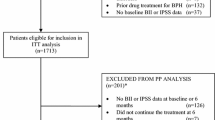Abstract
Background Lower urinary tract symptoms due to benign prostatic hyperplasia set restriction to patients’ daily life activities and decrease their quality of life. Adherence to medications is considered a core element to improve patients’ clinical outcomes. Objective To evaluate the role of clinical pharmacist in improving adherence to medication, reducing severity of symptoms, and improving quality of life in this group of patients. Setting The study was conducted in urology outpatients’ clinics in Amman, Jordan. Methods This was a prospective randomized controlled trial, patients were randomly allocated into intervention group or control group. Patients in the intervention group were offered a pharmaceutical care service and patients in the control group received regular healthcare provided by urologist and then followed for 1 month. Main outcome measures Morisky Medication Adherence Score and International Prostate Symptom Score. Results Among 209 patients completed the study, 105 were in the intervention group and 104 in the control group. By the end of the study, 91.4% of the intervention group patients became adherent to their medication compared to 72.1% in the control group (p < 0.0001). At follow up, the severity of the symptoms to calculated score was lower in the intervention group (mean 15.6 ± 5.69) compared to control group (mean 13.9 ± 5.43) (p < 0.0001). The quality of life score were better in the intervention group compared to the control group at follow-up (p < 0.0001). Conclusion The current findings indicate that implementing clinical pharmacy services can positively increase the level of adherence to medications. This was accompanied by modest improvement in the severity of urinary symptoms in benign prostatic hyperplasia and in quality of life for patients. Hence, clinical pharmacy services could provide beneficence in outpatient setting.
Similar content being viewed by others
References
Chughtai B, Forde JC, Thomas DD, Laor L, Hossack T, Woo HH. Benign prostatic hyperplasia. Nat Rev Dis Primers. 2016;2:16031.
Lloyd GL, Marks JM, Ricke WA. Benign prostatic hyperplasia and lower urinary tract symptoms: what is the role and significance of inflammation? Curr Urol Rep. 2019;20(9):54.
Kozminski MA, Wei JT, Nelson J, Kent DM. Baseline characteristics predict risk of progression and response to combined medical therapy for benign prostatic hyperplasia (BPH). BJU Int. 2015;115(2):308–18.
Lim KB. Epidemiology of clinical benign prostatic hyperplasia. Asian J Urol. 2017;4(3):148–51.
Lee SWH, Chan EMC, Lai YK. The global burden of lower urinary tract symptoms suggestive of benign prostatic hyperplasia: a systematic review and meta-analysis. Sci Rep. 2017;7(1):7984.
Langan RC. Benign prostatic hyperplasia. Prim Care. 2019;46(2):223–32.
De Nunzio C, Presicce F, Lombardo R, Trucchi A, Bellangino M, Tubaro A, et al. Patient centred care for the medical treatment of lower urinary tract symptoms in patients with benign prostatic obstruction: a key point to improve patients’ care—a systematic review. BMC Urol. 2018;18(1):62.
Auanet.org. American Urological Association—management of benign prostatic hyperplasia. 2018. https://www.auanet.org/education/guidelines/benign-prostatic-hyperplasia.cfm. Accessed 28 July 2018.
Mobley D, Feibus A, Baum N. Benign prostatic hyperplasia and urinary symptoms: evaluation and treatment. Postgrad Med. 2015;127(3):301–7.
Kim EH, Larson JA, Andriole GL. Management of benign prostatic hyperplasia. Annu Rev Med. 2016;67:137–51.
Strope SA. Evidence-based guidelines in lower urinary tract symptoms secondary to benign prostatic hyperplasia and variation in care. Curr Opin Urol. 2018;28(3):262–6.
Cindolo L, Pirozzi L, Fanizza C, Romero M, Tubaro A, Autorino R, et al. Drug adherence and clinical outcomes for patients under pharmacological therapy for lower urinary tract symptoms related to benign prostatic hyperplasia: population-based cohort study. Eur Urol. 2015;68(3):418–25.
Shortridge E, Donatucci C, Donga P, Marcus M, Wade RL. Adherence and persistence patterns in medication use among men with lower urinary tract symptoms/benign prostatic hyperplasia. Am J Men’s Health. 2017;11:164–9.
Zabkowski T, Saracyn M. Drug adherence and drug-related problems in pharmacotherapy for lower urinary tract symptoms related to benign prostatic hyperplasia. J Physiol Pharmacol. 2018;69(4):639–45.
Morisky DE, Ang A, Krousel-Wood M, Ward H. Predictive validity of a medication adherence measure for hypertension control. J Clin Hypertens. 2008;10(5):348–54.
Morisky DE, DiMatteo MR. Improving the measurement of self-reported medication nonadherence: final response. J Clin Epidemiol. 2011;64:258–63.
Berlowitz DR, Foy CG, Kazis LE, Bolin LP, Conroy MB, Fitzpatrick P, et al. Impact of intensive blood pressure therapy on patient-reported outcomes: outcomes results from the SPRINT study. N Engl J Med. 2017;377:733–44.
Usrf.org. USRF—International Prostate Symptom Score. 2016. http://www.usrf.org/questionnaires/AUA_SymptomScore.html. Accessed 29 July 2018.
Booth L, Skelton DA, Hagen S, Booth J. Identifying the most reliable and valid bladder health screening tool: a systematic review. Disabil Rehabil. 2019;29:1–20.
Fischer MA, Stedman MR, Lii J, Vogeli C, Shrank WH, Brookhart MA, et al. Primary medication non-adherence: analysis of 195,930 electronic prescriptions. J Gen Intern Med. 2010;25(4):284–90.
Ramanath KV, Balaji DB, Nagakishore CH, Kumar SM, Bhanuprakash M. A study on impact of clinical pharmacist interventions on medication adherence and quality of life in rural hypertensive patients. J Young Pharm. 2012;4(2):95–100.
Lindenmeyer A, Hearnshaw H, Vermeire E, Van Royen P, Wens J, Biot Y. Interventions to improve adherence to medication in people with type 2 diabetes mellitus: a review of the literature on the role of pharmacists. J Clin Pharm Ther. 2006;31(5):409–19.
Acknowledgements
Use of the ©MMAS is protected by US copyright and registered trademark laws. Permission for use was obtained. A license agreement is available from: Donald E. Morisky, MMAR LLC, 294 Lindura Court, Las Vegas, NV 89138-4632; dmorisky@gmail.com.
Author information
Authors and Affiliations
Corresponding author
Ethics declarations
Funding
This study was funded by the Deanship of Research/Jordan University of Science and Technology (Grant No. 20160173).
Conflicts of interest
There are no conflicts of interest to declare.
Additional information
Publisher's Note
Springer Nature remains neutral with regard to jurisdictional claims in published maps and institutional affiliations.
Rights and permissions
About this article
Cite this article
Ababneh, M., Shamieh, D., Al Demour, S. et al. Evaluation of the clinical pharmacist role in improving clinical outcomes in patients with lower urinary tract symptoms due to benign prostatic hyperplasia. Int J Clin Pharm 41, 1373–1378 (2019). https://doi.org/10.1007/s11096-019-00896-2
Received:
Accepted:
Published:
Issue Date:
DOI: https://doi.org/10.1007/s11096-019-00896-2




